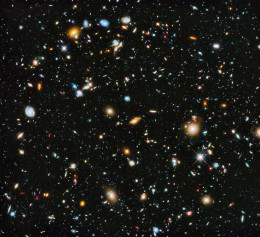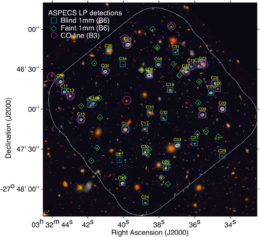The incredible power of ALMA, an array of telescopes located in the high deserts of Chile, has revolutionized our understanding of the structures built from gas and dust within our own galaxy. But ALMA can do more than that: it can also catalog the molecular gas and dust of galaxies located in the distant depths of our universe.

Hubble Ultra-Deep Field image, a composite of exposures taken 2003-2012 that reveals roughly 10,000 galaxies in just a small section of space. Click to enlarge. [NASA/ESA/H. Teplitz & M. Rafelski (IPAC/Caltech)/A. Koekemoer (STScI)/R. Windhorst (Arizona State University)/Z. Levay (STScI)]
With ALMA, we can gain insight into the cold molecular gas and dust content of galaxies over time — and the remarkable sensitivity of this observatory has been harnessed in a recent, ambitious project called The ALMA Spectroscopic Survey in the Hubble Ultra-Deep Field, or ASPECS.
The newest results from ASPECS are now published in a set of articles in the Astrophysical Journal. Below, we take a brief look at some of the main outcomes of the set, but you can find more details in the original articles and in the press releases linked at the end of the post.
Hidden Star Formation
A first step toward understanding star formation in the distant universe is to figure out which galaxies are forming stars, and at what rates. This is relatively straightforward when the star formation is visible — but often it’s obscured by dust, preventing us from getting clear measurements.
The high sensitivity ALMA is ideal for this situation, however, and ASPECS observations were used to probe the dust-enshrouded star formation in 1,362 galaxies in the HUDF that are located in the redshift range of z = 1.5–10.
Exploring Fuel for Stars
With a clearer picture of star formation over time, it next makes sense to examine the raw material used to make stars.

ASPECS detections within the HUDF. Pink circles denote molecular gas detections, blue squares denote dust, and green diamonds denote faint dust. Click to enlarge. [Aravena et al. 2020]
It’s generally understood that once the first stars started forming, star formation activity increased over time until it reached a peak at around z ~ 1–3, or “cosmic noon”. After that point, star formation activity substantially slowed to present day. The ASPECS observations now help us to better understand why.
ASPECS data show that the total amount of molecular gas in the universe increased until cosmic noon, when it began steadily declining. Today, the amount of molecular gas available for star formation is only around a tenth of what was available at cosmic noon! This is neatly consistent with that known cosmic history of star formation: star formation peaked at the same time as the molecular gas density peaked and has declined to present day — and will probably continue to decline until it ceases altogether.
What’s Next?
The ASPECS data is now being used to constrain cosmological models, helping us to better understand how galaxies evolve and stars are born. There’s still a lot of science to be done with the ASPECS observations, and today’s release of publications is just a start! Keep an eye out for more to come.
Bonus
Check out this video that demonstrates the locations of the dusty galaxies examined by ALMA, placed into context within the Hubble Ultra Deep Field.
[STScI, ASPECS Collaboration, Thomas Müller (HdA)]
Read More
ASPECS website
ALMA press release
MPIA press release
Citation
“The ALMA Spectroscopic Survey in the Hubble Ultra Deep Field: The nature of the faintest dusty star-forming galaxies,” Manuel Aravena et al 2020 ApJ 901 79. doi:10.3847/1538-4357/ab99a2
“The ALMA Spectroscopic Survey in the HUDF: CO Excitation and Atomic Carbon in Star-Forming Galaxies at z=1–3,” Leindert A. Boogaard et al 2020 ApJ 902 109. doi:10.3847/1538-4357/abb82f
“The ALMA Spectroscopic Survey in the HUDF: Multiband constraints on line–luminosity functions and the cosmic density of molecular gas,” Roberto Decarli et al 2020 ApJ 902 110. doi:10.3847/1538-4357/abaa3b
“The Evolution of the Baryons Associated with Galaxies Averaged over Cosmic Time and Space,” Fabian Walter et al 2020 ApJ 902 111. doi:10.3847/1538-4357/abb82e
“The ALMA Spectroscopic Survey Large Program: The Infrared Excess of z=1.5–10 UV-selected Galaxies and the Implied High-Redshift Star Formation History,” Rychard Bouwens et al 2020 ApJ 902 112. doi:10.3847/1538-4357/abb830
“The ALMA Spectroscopic Survey in the Hubble Ultra Deep Field: Constraining the Molecular Content at log(M*/M⊙) ~ 9.5 with CO Stacking of MUSE-detected z ~ 1.5 Galaxies,” Hanae Inami et al 2020 ApJ 902 113. doi:10.3847/1538-4357/abba2f


3 Comments
Pingback: From AAS NOVA: “A Deep Look at Distant Galaxies with ALMA” | sciencesprings
Pingback: Głębokie spojrzenie z ALMA na odległe galaktyki – PTMA Kraków
Pingback: Głębokie spojrzenie z ALMA na odległe galaktyki – Astronomia Śląska